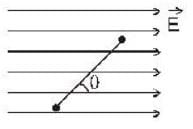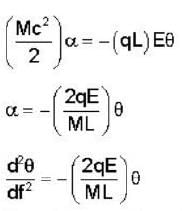GATE Exam > GATE Questions > A paint particle of mass M attached to one en...
Start Learning for Free
A paint particle of mass M attached to one end of a massless rigid non - conducting rod of length L. Another paint particle of the same mass is attached to the other end of the rod. The two particles carry changes + q and -q respectively. This arrangement is held in a region of a uniform electric field E such that the rod makes a small angle  with the field direction. Find the minimum time needed for the rod to become parallel to the field after it is set free
with the field direction. Find the minimum time needed for the rod to become parallel to the field after it is set free

 with the field direction. Find the minimum time needed for the rod to become parallel to the field after it is set free
with the field direction. Find the minimum time needed for the rod to become parallel to the field after it is set free
- a)

- b)

- c)

- d)

Correct answer is option 'A'. Can you explain this answer?
| FREE This question is part of | Download PDF Attempt this Test |
Verified Answer
A paint particle of mass M attached to one end of a massless rigid non...
A torque will act on the rod, which tries to align the rod in the direction of electric field. This torque will be of restoring nature and has a magnitude PE sinθ. Therefore

since θ is very small so that sin θ Sin θ ≈ θ

As α is proportional to - θ, motion of the rod is s impleharmonic in natural time period of which is given by

the desired time will be


since θ is very small so that sin θ Sin θ ≈ θ

As α is proportional to - θ, motion of the rod is s impleharmonic in natural time period of which is given by

the desired time will be


|
Explore Courses for GATE exam
|

|
Similar GATE Doubts
A paint particle of mass M attached to one end of a massless rigid non - conducting rod of length L. Another paint particle of the same mass is attached to the other end of the rod. The two particles carry changes + q and -q respectively. This arrangement is held in a region of a uniform electric field E such that the rod makes a small angle with the field direction. Find the minimum time needed for the rod to become parallel to the field after it is set freea)b)c)d)Correct answer is option 'A'. Can you explain this answer?
Question Description
A paint particle of mass M attached to one end of a massless rigid non - conducting rod of length L. Another paint particle of the same mass is attached to the other end of the rod. The two particles carry changes + q and -q respectively. This arrangement is held in a region of a uniform electric field E such that the rod makes a small angle with the field direction. Find the minimum time needed for the rod to become parallel to the field after it is set freea)b)c)d)Correct answer is option 'A'. Can you explain this answer? for GATE 2024 is part of GATE preparation. The Question and answers have been prepared according to the GATE exam syllabus. Information about A paint particle of mass M attached to one end of a massless rigid non - conducting rod of length L. Another paint particle of the same mass is attached to the other end of the rod. The two particles carry changes + q and -q respectively. This arrangement is held in a region of a uniform electric field E such that the rod makes a small angle with the field direction. Find the minimum time needed for the rod to become parallel to the field after it is set freea)b)c)d)Correct answer is option 'A'. Can you explain this answer? covers all topics & solutions for GATE 2024 Exam. Find important definitions, questions, meanings, examples, exercises and tests below for A paint particle of mass M attached to one end of a massless rigid non - conducting rod of length L. Another paint particle of the same mass is attached to the other end of the rod. The two particles carry changes + q and -q respectively. This arrangement is held in a region of a uniform electric field E such that the rod makes a small angle with the field direction. Find the minimum time needed for the rod to become parallel to the field after it is set freea)b)c)d)Correct answer is option 'A'. Can you explain this answer?.
A paint particle of mass M attached to one end of a massless rigid non - conducting rod of length L. Another paint particle of the same mass is attached to the other end of the rod. The two particles carry changes + q and -q respectively. This arrangement is held in a region of a uniform electric field E such that the rod makes a small angle with the field direction. Find the minimum time needed for the rod to become parallel to the field after it is set freea)b)c)d)Correct answer is option 'A'. Can you explain this answer? for GATE 2024 is part of GATE preparation. The Question and answers have been prepared according to the GATE exam syllabus. Information about A paint particle of mass M attached to one end of a massless rigid non - conducting rod of length L. Another paint particle of the same mass is attached to the other end of the rod. The two particles carry changes + q and -q respectively. This arrangement is held in a region of a uniform electric field E such that the rod makes a small angle with the field direction. Find the minimum time needed for the rod to become parallel to the field after it is set freea)b)c)d)Correct answer is option 'A'. Can you explain this answer? covers all topics & solutions for GATE 2024 Exam. Find important definitions, questions, meanings, examples, exercises and tests below for A paint particle of mass M attached to one end of a massless rigid non - conducting rod of length L. Another paint particle of the same mass is attached to the other end of the rod. The two particles carry changes + q and -q respectively. This arrangement is held in a region of a uniform electric field E such that the rod makes a small angle with the field direction. Find the minimum time needed for the rod to become parallel to the field after it is set freea)b)c)d)Correct answer is option 'A'. Can you explain this answer?.
Solutions for A paint particle of mass M attached to one end of a massless rigid non - conducting rod of length L. Another paint particle of the same mass is attached to the other end of the rod. The two particles carry changes + q and -q respectively. This arrangement is held in a region of a uniform electric field E such that the rod makes a small angle with the field direction. Find the minimum time needed for the rod to become parallel to the field after it is set freea)b)c)d)Correct answer is option 'A'. Can you explain this answer? in English & in Hindi are available as part of our courses for GATE.
Download more important topics, notes, lectures and mock test series for GATE Exam by signing up for free.
Here you can find the meaning of A paint particle of mass M attached to one end of a massless rigid non - conducting rod of length L. Another paint particle of the same mass is attached to the other end of the rod. The two particles carry changes + q and -q respectively. This arrangement is held in a region of a uniform electric field E such that the rod makes a small angle with the field direction. Find the minimum time needed for the rod to become parallel to the field after it is set freea)b)c)d)Correct answer is option 'A'. Can you explain this answer? defined & explained in the simplest way possible. Besides giving the explanation of
A paint particle of mass M attached to one end of a massless rigid non - conducting rod of length L. Another paint particle of the same mass is attached to the other end of the rod. The two particles carry changes + q and -q respectively. This arrangement is held in a region of a uniform electric field E such that the rod makes a small angle with the field direction. Find the minimum time needed for the rod to become parallel to the field after it is set freea)b)c)d)Correct answer is option 'A'. Can you explain this answer?, a detailed solution for A paint particle of mass M attached to one end of a massless rigid non - conducting rod of length L. Another paint particle of the same mass is attached to the other end of the rod. The two particles carry changes + q and -q respectively. This arrangement is held in a region of a uniform electric field E such that the rod makes a small angle with the field direction. Find the minimum time needed for the rod to become parallel to the field after it is set freea)b)c)d)Correct answer is option 'A'. Can you explain this answer? has been provided alongside types of A paint particle of mass M attached to one end of a massless rigid non - conducting rod of length L. Another paint particle of the same mass is attached to the other end of the rod. The two particles carry changes + q and -q respectively. This arrangement is held in a region of a uniform electric field E such that the rod makes a small angle with the field direction. Find the minimum time needed for the rod to become parallel to the field after it is set freea)b)c)d)Correct answer is option 'A'. Can you explain this answer? theory, EduRev gives you an
ample number of questions to practice A paint particle of mass M attached to one end of a massless rigid non - conducting rod of length L. Another paint particle of the same mass is attached to the other end of the rod. The two particles carry changes + q and -q respectively. This arrangement is held in a region of a uniform electric field E such that the rod makes a small angle with the field direction. Find the minimum time needed for the rod to become parallel to the field after it is set freea)b)c)d)Correct answer is option 'A'. Can you explain this answer? tests, examples and also practice GATE tests.

|
Explore Courses for GATE exam
|

|
Suggested Free Tests
Signup for Free!
Signup to see your scores go up within 7 days! Learn & Practice with 1000+ FREE Notes, Videos & Tests.


















